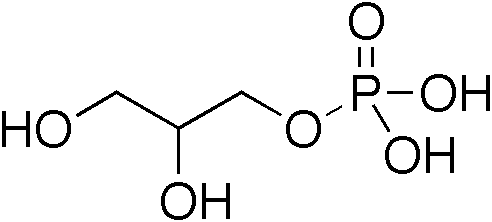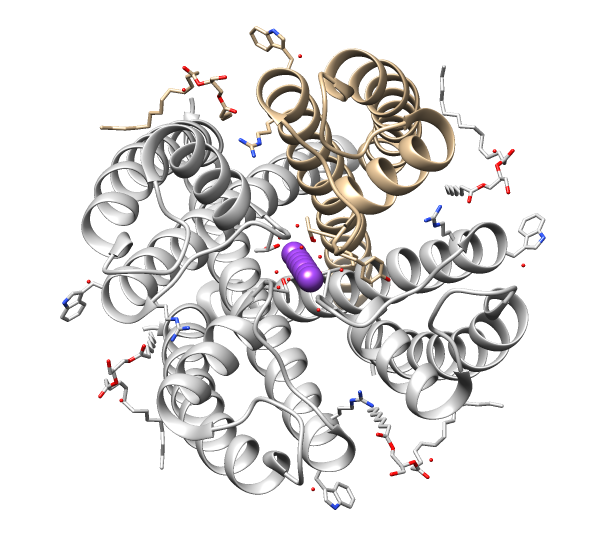|
TRPC
TRPC is a family of transient receptor potential cation channels in animals. TRPC channels form the subfamily of channels in humans most closely related to drosophila TRP channels. Structurally, members of this family possess a number of similar characteristics, including 3 or 4 ankyrin repeats near the N-terminus and a TRP box motif containing the invariant EWKFAR sequence at the proximal C-terminus. These channels are non-selectively permeable to cations, with a prevalence of calcium over sodium variable among the different members. Many of TRPC channel subunits are able to coassemble. The predominant TRPC channels in the mammalian brain are the TRPC 1,4 and 5 and they are densely expressed in corticolimbic brain regions, like the hippocampus, prefrontal cortex and lateral septum. These 3 channels are activated by the metabotropic glutamate receptor 1 agonist dihydroxyphenylglycine. In general, TRPC channels can be activated by phospholipase C stimulation, with some me ... [...More Info...] [...Related Items...] OR: [Wikipedia] [Google] [Baidu] |
TRPC1
Transient receptor potential canonical 1 (TRPC1) is a protein that in humans is encoded by the ''TRPC1'' gene. Function TRPC1 is an ion channel located on the plasma membrane of numerous human and animal cell types. It is a nonspecific cation channel, which means that both sodium and calcium ions can pass through it. TRPC1 is thought to mediate calcium entry in response to depletion of endoplasmic calcium stores or activation of receptors coupled to the phospholipase C system. In HEK293 cells the unitary current-voltage relationship of endogenous TRPC1 channels is almost linear, with a slope conductance of about 17 pS. The extrapolated reversal potential of TRPC1 channels is +30 mV. The TRPC1 protein is widely expressed throughout the mammalian brain and has a similar corticolimbic expression pattern as TRPC4 and TRPC5. The highest density of TRPC1 protein is found in the lateral septum, an area with dense TRPC4 expression, and hippocampus and prefrontal cortex, areas with de ... [...More Info...] [...Related Items...] OR: [Wikipedia] [Google] [Baidu] |
TRPC3
Short transient receptor potential channel 3 (TrpC3) also known as transient receptor protein 3 (TRP-3) is a protein that in humans is encoded by the TRPC3 gene. The TRPC3/6/7 subfamily are implicated in the regulation of vascular tone, cell growth, proliferation and pathological hypertrophy. These are diacylgylcerol-sensitive cation channels known regulate intracellular calcium via activation of the phospholipase C (PLC) pathway and/or by sensing Ca2+ store depletion. Together, their role in calcium homeostasis has made them potential therapeutic targets for a variety of central and peripheral pathologies. Function Non-specific cation conductance elicited by the activation of TrkB by BDNF is TRPC3-dependent in the CNS. TRPC channels are almost always co-localized with mGluR1-expressing cells and likely play a role in mGluR-mediated EPSPs. The TRPC3 channel has been shown to be preferentially expressed in non-excitable cell types, such as oligodendrocytes. However, evidence ... [...More Info...] [...Related Items...] OR: [Wikipedia] [Google] [Baidu] |
Transient Receptor Potential Channel
Transient receptor potential channels (TRP channels) are a group of ion channels located mostly on the plasma membrane of numerous animal cell types. Most of these are grouped into two broad groups: Group 1 includes TRPC ( "C" for canonical), TRPV ("V" for vanilloid), TRPVL ("VL" for vanilloid-like), TRPM ("M" for melastatin), TRPS ("S" for soromelastatin), TRPN ("N" for no mechanoreceptor potential C), and TRPA ("A" for ankyrin). Group 2 consists of TRPP ("P" for polycystic) and TRPML ("ML" for mucolipin). Other less-well categorized TRP channels exist, including yeast channels and a number of Group 1 and Group 2 channels present in non-animals. Many of these channels mediate a variety of sensations such as pain, temperature, different kinds of tastes, pressure, and vision. In the body, some TRP channels are thought to behave like microscopic thermometers and used in animals to sense hot or cold. Some TRP channels are activated by molecules found in spices like garlic ( ... [...More Info...] [...Related Items...] OR: [Wikipedia] [Google] [Baidu] |
TRPC6
Transient receptor potential cation channel, subfamily C, member 6, also known as TRPC6, is a human gene encoding a protein of the same name. TRPC6 is a transient receptor potential channel of the classical TRPC subfamily. It has been associated with depression and anxiety (see below), as well as with focal segmental glomerulosclerosis (FSGS). Interactions TRPC6 has been shown to interact with: * FYN, * TRPC2, and * TRPC3. Ligands Two of the primary active constituents responsible for the antidepressant and anxiolytic benefits of ''Hypericum perforatum'', also known as St. John's Wort, are hyperforin and adhyperforin. These compounds are inhibitors of the reuptake of serotonin, norepinephrine, dopamine, γ-aminobutyric acid, and glutamate, and they are reported to exert these effect Effect may refer to: * A result or change of something ** List of effects ** Cause and effect, an idiom describing causality Pharmacy and pharmacology * Drug effect, a change resulti ... [...More Info...] [...Related Items...] OR: [Wikipedia] [Google] [Baidu] |
Calcium Release Activated Channel
Calcium release-activated channels (CRAC) are specialized plasma membrane Ca2+ ion channels. When calcium ions (Ca2+) are depleted from the endoplasmic reticulum (a major store of Ca2+) of mammalian cells, the CRAC channel is activated to slowly replenish the level of calcium in the endoplasmic reticulum. The Ca2+ Release-activated Ca2+ (CRAC) Channel (CRAC-C) Family (TC# 1.A.52) is a member of the Cation Diffusion Facilitator (CDF) Superfamily. These proteins typically have between 4 and 6 transmembrane α-helical spanners (TMSs). The 4 TMS CRAC channels arose by loss of 2TMSs from 6TMS CDF carriers, an example of ' reverse' evolution'. Homology There are several proteins that belong to the CRAC-C family. A list of the currently classified members of the CRAC-C family can be found in thTransporter Classification Database This classification is based on sequence similarity which also happens to coincide with functional and structural similarities between homologues. Structure ... [...More Info...] [...Related Items...] OR: [Wikipedia] [Google] [Baidu] |
Diacylglycerol
A diglyceride, or diacylglycerol (DAG), is a glyceride consisting of two fatty acid chains covalently bonded to a glycerol molecule through ester linkages. Two possible forms exist, 1,2-diacylglycerols and 1,3-diacylglycerols. DAGs can act as surfactants and are commonly used as emulsifiers in processed foods. DAG-enriched oil (particularly 1,3-DAG) has been investigated extensively as a fat substitute due to its ability to suppress the accumulation of body fat; with total annual sales of approximately USD 200 million in Japan since its introduction in the late 1990s till 2009. Production Diglycerides are a minor component of many seed oils and are normally present at ~1–6%; or in the case of cottonseed oil as much as 10%. Industrial production is primarily achieved by a glycerolysis reaction between triglycerides and glycerol. The raw materials for this may be either vegetable oils or animal fats. Food additive Diglycerides, generally in a mix with monoglycerides (E471), ar ... [...More Info...] [...Related Items...] OR: [Wikipedia] [Google] [Baidu] |
Diglyceride
A diglyceride, or diacylglycerol (DAG), is a glyceride consisting of two fatty acid chains covalently bonded to a glycerol molecule through ester linkages. Two possible forms exist, 1,2-diacylglycerols and 1,3-diacylglycerols. DAGs can act as surfactants and are commonly used as emulsifiers in processed foods. DAG-enriched oil (particularly 1,3-DAG) has been investigated extensively as a fat substitute due to its ability to suppress the accumulation of body fat; with total annual sales of approximately USD 200 million in Japan since its introduction in the late 1990s till 2009. Production Diglycerides are a minor component of many seed oils and are normally present at ~1–6%; or in the case of cottonseed oil as much as 10%. Industrial production is primarily achieved by a glycerolysis reaction between triglycerides and glycerol. The raw materials for this may be either vegetable oils or animal fats. Food additive Diglycerides, generally in a mix with monoglycerides ... [...More Info...] [...Related Items...] OR: [Wikipedia] [Google] [Baidu] |
Ion Channel
Ion channels are pore-forming membrane proteins that allow ions to pass through the channel pore. Their functions include establishing a resting membrane potential, shaping action potentials and other electrical signals by gating the flow of ions across the cell membrane, controlling the flow of ions across secretory and epithelial cells, and regulating cell volume. Ion channels are present in the membranes of all cells. Ion channels are one of the two classes of ionophoric proteins, the other being ion transporters. The study of ion channels often involves biophysics, electrophysiology, and pharmacology, while using techniques including voltage clamp, patch clamp, immunohistochemistry, X-ray crystallography, fluoroscopy, and RT-PCR. Their classification as molecules is referred to as channelomics. Basic features There are two distinctive features of ion channels that differentiate them from other types of ion transporter proteins: #The rate of ion transpor ... [...More Info...] [...Related Items...] OR: [Wikipedia] [Google] [Baidu] |
Fibroblasts
A fibroblast is a type of biological cell that synthesizes the extracellular matrix and collagen, produces the structural framework ( stroma) for animal tissues, and plays a critical role in wound healing. Fibroblasts are the most common cells of connective tissue in animals. Structure Fibroblasts have a branched cytoplasm surrounding an elliptical, speckled nucleus having two or more nucleoli. Active fibroblasts can be recognized by their abundant rough endoplasmic reticulum. Inactive fibroblasts (called fibrocytes) are smaller, spindle-shaped, and have a reduced amount of rough endoplasmic reticulum. Although disjointed and scattered when they have to cover a large space, fibroblasts, when crowded, often locally align in parallel clusters. Unlike the epithelial cells lining the body structures, fibroblasts do not form flat monolayers and are not restricted by a polarizing attachment to a basal lamina on one side, although they may contribute to basal lamina component ... [...More Info...] [...Related Items...] OR: [Wikipedia] [Google] [Baidu] |
Angiotensin II
Angiotensin is a peptide hormone that causes vasoconstriction and an increase in blood pressure. It is part of the renin–angiotensin system, which regulates blood pressure. Angiotensin also stimulates the release of aldosterone from the adrenal cortex to promote sodium retention by the kidneys. An oligopeptide, angiotensin is a hormone and a dipsogen. It is derived from the precursor molecule angiotensinogen, a serum globulin produced in the liver. Angiotensin was isolated in the late 1930s (first named 'angiotonin' or 'hypertensin') and subsequently characterized and synthesized by groups at the Cleveland Clinic and Ciba laboratories. Precursor and types Angiotensinogen Angiotensinogen is an α-2-globulin synthesized in the liver and is a precursor for angiotensin, but has also been indicated as having many other roles not related to angiotensin peptides. It is a member of the serpin family of proteins, leading to another name: Serpin A8, although it is not know ... [...More Info...] [...Related Items...] OR: [Wikipedia] [Google] [Baidu] |
Hypertrophy
Hypertrophy is the increase in the volume of an organ or tissue due to the enlargement of its component cells. It is distinguished from hyperplasia, in which the cells remain approximately the same size but increase in number.Updated by Linda J. Vorvick. 8/14/1Hyperplasia/ref> Although hypertrophy and hyperplasia are two distinct processes, they frequently occur together, such as in the case of the hormonally-induced proliferation and enlargement of the cells of the uterus during pregnancy. Eccentric hypertrophy is a type of hypertrophy where the walls and chamber of a hollow organ undergo growth in which the overall size and volume are enlarged. It is applied especially to the left ventricle of heart. Sarcomeres are added in series, as for example in dilated cardiomyopathy (in contrast to hypertrophic cardiomyopathy, a type of concentric hypertrophy, where sarcomeres are added in parallel). Gallery File:*+ * Photographic documentation on sexual education - Hypertrophy o ... [...More Info...] [...Related Items...] OR: [Wikipedia] [Google] [Baidu] |


.jpg)
